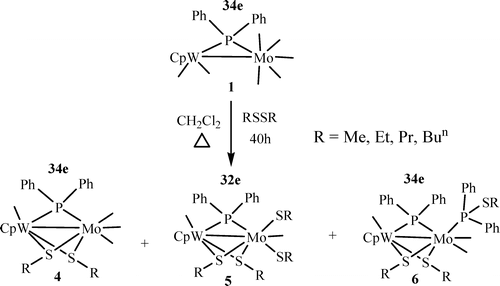Activation of the S-S bonds of alkyl disulfides RSSR (R = Me, Et, Pr, Bu-n) by heterodinuclear phosphido-bridged CpW(Co)(2)(mu-PPh2)Mo(CO)(5)
Submitted by Jun Zhu on Thu, 10/31/2013 - 23:51
Reactions of CpW(CO)(2)(mu-PPh2)Mo(CO)(5) (1) with alkyl disulfides RSSR (R = Me, Et, Pr, Bu-n) in refluxing dichloromethane yielded the series of new mixed-metal and mixed-ligand bridged compounds CpW(CO)(mu-SR)(2)(mu-PPh2)Mo(CO)(3) (R = Me (4a), Et (4b), Pr (4c), Bun (4d)), CpW(CO)(mu-SR)2(mu-PPh2)Mo(CO)(mu-SR)(2) (R = Me (5a), Et (5b), Pr (5c), Bu-n (5d)), and CpW(CO)(mu-SR)(2)(mu-PPh2) Mo(CO)(2)(PPh2SR) (R = Me (6a), Et (6b), Pr (6c), Bu-n (6d)). All except 6c were characterized by single-crystal X-ray diffraction analysis.



